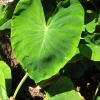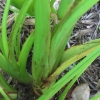Use As Food
Makes fairly good poi. Goup piko are known to make good poi.
Distribution
Mainly as a mixture among other Piko varieties. Taro of this family are common grown in lo‘i (wetland), and are very tough with a resistance to root rot.
General Characteristics
Closely resembles Piko Kea, but maturing within 12 to 15 months.
Ha (Petiole)
60 to 95 cm. long, light green, pinkish red at edge, usually with adjacent dark green blotches especially near kōhina (base), white at kōhina (base).
Lau or Lu'au(Leaf Blade)
30 to 45 cm. long, 25 to 35 cm, wide, 20 to 35 cm, fromtip to base of sinus (māwae), egg-shaped (ovate), pendant, light to (lark green; piko whitish; round leaf section (lobes) narrow and obtuse with narrow lihi māwae (sinus).
'I'o kalo (Corm)
Flesh chalky white with light yellow fibers; skin cream-colored.
Pua (Flower)
Remarks
18. Piko Kea and 19. Piko Ke‘oke‘o are similar in appearance. Differs in that Piko Ke‘oke‘o has a white H& #257; (Petiole) kōhina (ring at base of petiole) and chalky white ‘i‘o kalo (Corm) flesh; while Piko Kea has a pinkish kōhina. We call these two sisters because they both have light green Hā (Petiole).






